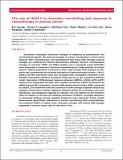The role of HDAC2 in chromatin remodelling and response to chemotherapy in ovarian cancer
Abstract
Chromatin undergoes structural changes in response to extracellular and environmental signals. We observed changes in nuclear morphology in cancer tissue biopsied after chemotherapy and hypothesised that these DNA damage-induced changes are mediated by histone deacetylases (HDACs). Nuclear morphological changes in cell lines and a xenograft model (OV1002) weremeasured in response to platinum chemotherapy by image analysis of nuclear texture. HDAC2 expression increased in PEO1 cells treated with cisplatin at 24h, which was accompanied by increased expression of heterochromatin protein 1 (HP1). HDAC2 and HP1 expression were also increased after carboplatin treatment in the OV1002 carboplatin-sensitive xenograft model but notin the insensitive HOX424 model. Expression of DNA damage response pathways (pBRCA1, γH2AX, pATM, pATR) showed time-dependent changes after cisplatin treatment. HDAC2 knockdown by siRNA reduced HP1 expression, induced DNA double strand breaks (DSB) measured by γH2AX, and interfered with the activation of DNA damage responses induced by cisplatin. Furthermore, HDAC2depletion affected γH2AX foci formation, cell cycle distribution, and apoptosis triggered by cisplatin and was additive to the inhibitory effect of cisplatin in cell lines. By inhibiting HDAC2 expression, reversible alterations in chromatin patterns during cisplatin treatment were observed. These results demonstrate quantifiable alterations in nuclear morphology after chemotherapy and implicateHDAC2 in higher-order chromatin changes and cellular DNA damage responses in ovarian cancer cells in vitro and in vivo.
Citation
Huang , R , Langdon , S P , Tse , M , Mullen , P , Um , I H , Faratian , D & Harrison , D J 2015 , ' The role of HDAC2 in chromatin remodelling and response to chemotherapy in ovarian cancer ' , Oncotarget , vol. 7 , no. 4 , pp. 4695-4711 . https://doi.org/10.18632/oncotarget.6618
Publication
Oncotarget
Status
Peer reviewed
ISSN
1949-2553Type
Journal article
Description
This study was supported by financial support from the University of Edinburgh/China Scholarship Council joint Scholarship Scheme. We are also grateful to support from the Scottish Funding Council.Collections
Items in the St Andrews Research Repository are protected by copyright, with all rights reserved, unless otherwise indicated.

